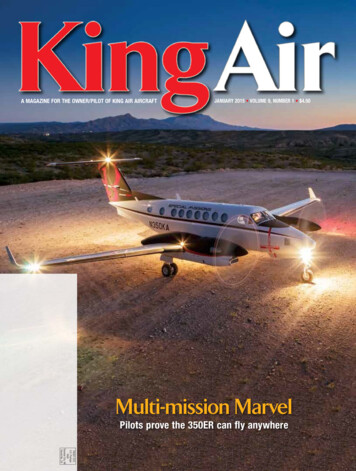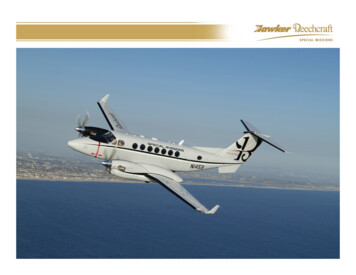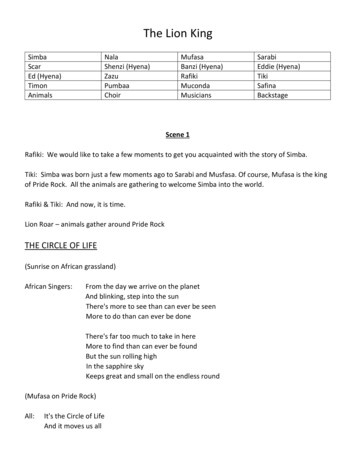
Transcription
A MAGAZINE FOR THE OWNER/PILOT OF KING AIR AIRCRAFTJANUARY 2015 VOLUME 9, NUMBER 1 4.50Multi-mission MarvelPilots prove the 350ER can fly anywherePRSRT STDU.S. PostagePAIDTraverse City, MIPermit No. 29JANUARY 2015KING AIR MAGAZINE 1
2 KING AIR MAGAZINEJANUARY 2015
KingAirA MAGAZINE FOR THE OWNER/PILOT OF KING AIR AIRCRAFT4EDITORKim BlonigenEDITORIAL OFFICE2779 Aero Park Dr., Traverse City MI 49686Phone: (316) 652-9495E-mail: kblonigen@cox.netPUBLISHERSJ. Scott LizenbyDave MooreVillage PublicationsJANUARY 201512PRODUCTION MANAGERMike RevardPUBLICATIONS DIRECTORSteve SmithADVERTISING DIRECTORJohn ShoemakerKing Air Magazine2779 Aero Park DriveTraverse City, MI 49686Phone: 1-800-773-7798Fax: (231) 946-9588E-mail: johns@villagepress.comADVERTISING EXECUTIVE ASSISTANTBetsy BeaudoinPhone: 1-800-773-7798E-mail: betsybeaudoin@villagepress.com2Letters to the EditorONLINE ADDRESSwww.kingairmagazine.comSUBSCRIPTIONSKing Air is distributed at no charge to all registeredowners of King Air aircraft. The mailing list isupdated bi-monthly. All others may subscribe bywriting to: King Air, P.O. Box 968, Traverse City,MI 49685, or by calling 1-800-447-7367. Ratesfor one year, 12 issues: United States 19.95,Canada 29.95 (U.S. funds), all other foreign 32.95 (U.S. funds). Single copies: United States 4.50, Canada/Foreign 6.50.COVER PHOTOPhoto courtesy ofMike FizerJANUARY 201521Walter H. Beech and theFord Reliability Tours4Proving the ER inthe King Air 350ERby MeLinda Schnyder12Airplanes, Cars,and Tugs do Collide so Who Pays?by Kyle WhiteSUBSCRIBER SERVICESDeb Neuman, Mgr.San Juana FisherMaria MellbergP.O. Box 968Traverse City, MI 496851-800-447-736721ContentsGRAPHIC DESIGNLuana DuewekeVolume 9 / Number 1by Edward H. Phillips28Value Added31Technically.32Advertiser Index18Ask the Expert –Fuel Crossfeed Why Can’t We Do It?!by Tom ClementsKing Air is wholly owned by Village Press, Inc. and is in no way associated with or a product of Textron Aviation.King Air (ISSN 1938-9361) is published twelve times a year by Village Press, Inc. with advertising offices located at 2779 Aero ParkDrive, Traverse City, Michigan 49686. Telephone (231) 946-3712. Printed in the United States of America. All rights reserved.Copyright 2015, Village Publications.ADVERTISING: Advertising in King Air does not necessarily imply endorsement. Queries, questions, and requests for media kitsshould be directed to the Advertising Director, King Air, P.O. Box 968, Traverse City, Michigan 49685. Telephone 1-800-773-7798.MANUSCRIPTS: King Air assumes no responsibility for unsolicited manuscripts, photographs, or art work. While unsolicited submissions are welcome, it is best to query first and ask for our Writer’s Guidelines. All unassigned submissions must be accompanied byreturn postage. Address queries and requests for Writer’s Guidelines to the editor.POSTMASTER: Send address changes and inquiries to King Air, Village Press, Inc., P.O. Box 968, Traverse City, MI 49685.KING AIR MAGAZINE 1
Letters TO THE EDITORThank youI would like to say thanks to you and King Air magazinefor your help in asking Tom Clements my question aboutCleveland brakes. I must say I was surprised to haveemailed you the question on Friday afternoon and gettinga response that night from Tom. I was in the middle ofa three- and four-phase check and had hoped to get ananswer soon enough to take advantage of a better brake.Thanks to all, I have ordered the new brakes for myB200. I am sure I will be pleased with the new brakes.WBCA Recent Flight with Executive AirI am Managing Director, as well as one of the pilots ofExecutive Air, a charter and MEDEVAC company of 30 years,based at Charles Prince Airport in Harare, Zimbabwe.Caroline, my partner in business as well as life, andI were returning to Harare after picking up our patientsfrom Ghanzi, in western central Botswana. We were flyingour King Air 200 on this MEDEVAC and had been cleareddirect to Harare from Ghanzi at FL270. It was a dark,stormy night with some lightning from the dissipatingstorms that we had negotiated on the way in to Ghanzi.As we were reaching our flight level, we heard SouthAfrican Airways SA203 talking to Gaborone Control abouttheir MAYDAY call. They had smoke in the cockpit! Thisgot our attention and our thoughts were with the crew andpassengers on that aircraft. We heard them downgradethe MAYDAY to a PAN call and they told Gaborone thatthey would be going back to Johannesburg. I think theyhad 215 passengers and 12 crewmembers on the aircraft.Gaborone told them that they would be watching theirprogress constantly. The crew, a man and woman, soundedvery much in control, although the situation was still tense!They then requested permission to jettison fuel along theairway they were flying. I thought to myself that this wasso that they would be within the weight limit the aircrafthad for the landing when they got back to Johannesburg.Gaborone told them that they would need to wait for eightminutes before dumping, in order to have the requiredclearance between another aircraft apparently on the samerouting. Gaborone duly called them at the appropriate timeand told them to go ahead with the fuel jettison. Carolineand I chatted about the possible situation that these chapswere in and we both agreed that we were glad it wasn’t usin that plane, wherever they were.We were making good speed at FL270, about 260 knotsdespite the clouds and lightning. We were passing southabeam Maun at about 1940Z time when there was a brightlightning flash and the plane shuddered a bit. Caroline andI mentioned that we may get a bit of turbulence from theweather. I put on the seat belt sign with chimes to remindour passengers to tighten their belts.2 KING AIR MAGAZINEThen Caroline said she was losing anengine! We both checked and confirmed the left enginetorque had started fluctuating. Then the engine startedsurging with loud bangs and flames blowing from theexhausts to beyond the wing. This was shortly followed bythe same on the right engine!Adrenaline was now at peak! We checked all the gaugesand besides fluctuation on the torque meters, the othergauges were holding steady with the correct readings!However, the surging and noise were seriously off-puttingand we were concerned for our safety, to put it mildly. Wehad not covered anything like this before in our sessionsin the simulator or in our previous flights.When the situation had not gotten any better for whatwas probably only a couple of minutes, we decided to divertto Maun. I informed Gaborone control that our engineswere surging and that we wanted to divert to Maun toassess the problem. Caroline turned left toward Maun andstarted the descent. As she did that, we got the engine firewarning in cabin on our annunciator panel. The engineswere still surging and spitting impressive flames; howeverall appeared to be coming out of the exhausts and nothingfrom the nacelles. I cancelled the warning light and kept awatch on the engines. At the same time, I was talking toMaun and telling them we were descending for their fieldwith engine problems.During the descent, I thought about the SA203 fueljettisoning and told Caroline that is what I thought wasthe problem. I told her to stop the descent and climbback to FL250 and turn back on course for Harare. Wewould see if the problem would go away. It was not longafter returning to our course that the two engines startedperforming properly again. I told Maun and Gaborone thatwe had resumed our course and that all appeared okay!I then called SA203 and asked them if they hadjettisoned their fuel in the vicinity of Maun? Yes theyhad! I thanked them for the excitement and all returnedto normal for the rest of our flight home.What had happened? I believe that we had beenoverlooked by Gaborone control and had been allowed tofly through the mist of jettisoned fuel from SA203! Whenwe entered this fuel rich air, the engines were choked withtoo much fuel and not enough air for combustion. Then,maybe there were less dense patches and the engines thenflamed up with the excess fuel lighting up outside theengines. This went on for a couple of minutes, although itfelt much longer!The engines then performed flawlessly for the rest ofthe flight. We are now waiting for the report from ourengineers to see if any damage has been suffered withinthe engines. We’ve got crossed fingers!Has anyone else had a similar experience or have anybrainwaves on alternative courses of action in this situation?JANUARY 2015
Thank goodness, Executive Air is still here to flyyou there!Ed MordtGeneral Manager, Executive AirEditor’s Note: As a follow-up to his letter, Mr. Mordtsent the following:KING AIRWINDOW INSERTSSTC’D-PMA / FAA APPROVEDWe were advised by the Pratt and Whitney representativefor Africa to do the following, which he received fromheadquarters.What Is the DifferenceBetween the G & D Aero Tinted Window InsertInsert?and the Polaroid Interior Window InserIf there were no exceedances of engine parameters, itwas recommended to do a boroscope of the hot section,compressor, including access via the bleed valve inorder to see that there was no ignition in the compressor.As a precaution, an oil change should be carried out asa possibility that fuel entered the oil system. If you needany assistance regarding BVI findings, please forwardthe pictures or video for further evaluation. If possibleplease provide airframe and engine details (airframeand engines serial numbers) including hours and cyclesfor our internal system requirement.The CostMy engineers have had a good look at the engines anddid the boroscope as recommended. We have also takenan oil sample from the engines and sent them for analysis.The engines have no symptoms or signs of any damagefrom the incident. We have since done another MEDEVACflight and the aircraft performed flawlessly.With the G & D Aero tinted window you have fulltime protection against the sun and the ability tokeep your passengers cool and comfortable. Noneed to make any adjustments to the windowsbecause the inserts work full time.G & D AEROR PROROPRODUCTSRODUROODUCTS951-443-1224A l l Beechcra f t / HawkerTypes Gold Ti-Ni Sputteredor Satin Buffed StainlessSteel Angled Rings & SkidsAll Beechcraft/Hawker Owners!Get 40 Instant Discount Rebateif purchase Stainless Rings & Skid230 MPHWind-Safeand “Angled”Visit www.AeroMechTech.comTel 952-334-7117info@aeromechtech.comor call Aircraft Spruce:1-877-4-SpruceJANUARY 2015KING AIR MAGAZINE 3
Proving the ERin theCompany pilots verify extended rangewith California-Hawaii flightsby MeLinda SchnyderSince the extended-range King Air 350ER wascertified in 2007, Beechcraft has promoted it asa solution for government and private operatorswho need to get anywhere in the world without usingcabin space for ferry fuel tanks and spending timemaking modifications or de-modifications.
King Air 350ERBeechcraft used N350KA – a standard production configuration King Air350ER – to fly the California-Hawaii route and demonstrate that operatorscan go anywhere in the world in this airplane without the need for installinginternal ferry tanks. (PHOTO CREDIT: MIKE FIZER)
N350KA (serial number FL-924) is one of Beechcraft’s two King Air 350ER special mission demonstrators that tour the world showcasingthe model’s multi-mission versatility and reliability. (PHOTO CREDIT: MIKE FIZER)In September, two longtime Beechcraft companypilots completed flights to verify the promisedperformance was not just a marketing claim. The resultsshould be helpful for future sales of a model that hasmore than 120 serving a variety of military and civilianroles across the globe.“This is the first time a King Air class airplane hasmade the California to Hawaii leg without additionalferry fuel tanks,” said Dan Keady, vice president, SpecialMissions for Textron Aviation. “We’ve been touting theKing Air 350ER’s endurance, range, payload and missionflexibility and now we’ve demonstrated the airplane’sunique deployment capabilities.”Here’s a look at the planning and execution ofthe flights.The PreparationIn August, sales demonstration pilots John Guidryand Mark Mohler were selected by Textron Aviation’schief pilot of turboprops to begin working with one ofthe company’s contracted flight planning agencies tolook at routing, altitude and weather options for themission. They settled on a route starting at California’sNapa County Airport (KAPC) to Hawaii’s HonoluluInternational Airport (PHNL).6 KING AIR MAGAZINE“Our team worked closely with our flight planningagency to see what type of forecast winds aloft wouldbe present for the September timeframe targeted forthe mission,” Mohler said. “We also looked at a varietyof altitudes to fly the mission. One of the selling pointsof the King Air models is the ability to fly missions atdifferent altitudes economically. We were interestedin flying the trip in the mid 20,000-foot range, as wellas the lower 30,000-foot range to show the ability toburn roughly the same amount of fuel with the altitudevariances. We proved this by flying to Honolulu at FL280,and returning at FL310 then FL330 and burning thesame amount of fuel (with the average wind componentbeing the same).”The PilotsAs demonstration pilots, Guidry’s and Mohler’s daysare spent working with a global sales force to demonstrateaircraft capabilities and providing transportation forTextron Aviation personnel. They were both thrilledwith the proving flight challenge and they split pilotin-command duties, Guidry taking the flight to Hawaiiand Mohler taking the return flight to California.This wasn’t the longest flight in a King Air forMohler, who previously flew a 350ER 10 hours andJANUARY 2015
JANUARY 2015KING AIR MAGAZINE 7
A standard production configuration King Air 350ER is a King Air 350i with several minor airframe modifications, aft-engine mountedfuel tanks and heftier landing gear to handle the increase in weight. (PHOTO CREDIT: MIKE FIZER)six minutes on an endurance mission from St.Petersburg, Florida, to Yakima, Washington. Aftergraduating from Wright State University in Dayton,Ohio, Mohler was a flight instructor then advanced fromfirst officer to captain at a regional airline. He missedinstructing so he moved to Wichita, Kansas, for a jobat FlightSafety International’s Beechcraft LearningCenter. In 1997, Raytheon Aircraft hired Mohler forwhat he calls the best flying job in aviation.“It is diverse and never has a dull moment,” saidMohler, who enters his 18th year flying for the companywith just over 13,000 hours. “I get to fly brand newairplanes all over the world. As we like to say, ‘I’m ‘livingthe dream.’”Guidry has been a pilot at Beechcraft for more than25 years, joining the company in 1989 after stints givingflying lessons, flying freight, then flying for a regionalairline. He is based in Atlanta, Georgia, and has 13,600total flight hours since he started flying at age 24.“Being with Beechcraft for 25-plus years now, I’veseen the King Air mature into the best turboprop in theworld,” Guidry said. “In my opinion, the King Air 350and 350ER are the best. The multi-role mission of thisairplane is incredible. I’m very proud to have proved thatby flying the first King Air from California to Hawaiinonstop without having to put in internal fuel tanks.”8 KING AIR MAGAZINEThe AircraftFor the proving flights, Beechcraft used a standardproduction configuration King Air 350ER, which isbased on the King Air 350i with several minor airframemodifications, aft-engine mounted fuel tanks and heftierlanding gear to handle the increase in weight. Thecompany advertises that the 350ER could take off atgross weight with full fuel and full payload, fly out100 nautical miles, perform a low altitude surveillancemission for seven hours and 20 minutes, fly back 100nautical miles and still land with more than 45 minutesof fuel on board.About three of every four King Air 350ER aircraftdelivered (80 of 120-plus) have gone to Departmentof Defense-type customers around the globe. Therehave been a handful delivered to private operatorsfor executive transport and commercial ventures likeSundt Air in Norway who use the 350ER to contractwith various agencies for oil pollution patrol, fisheryinspection flights, border patrol and search and rescuemissions. Aside from surveillance, the most popularuses of the 350ER are air ambulance, aerial survey,transporting people or freight, flight inspection/airwaycalibration and radar/navigation training.One of the more visible operators of the 350ER is theUnited States Air Force, which uses a fleet of 350 andJANUARY 2015
N350KA’s interior shows both a four-seat executive club configurationincluding writing tables in the front cabin (top) and an air ambulanceconfiguration with a fully functioning medical station including medicaloxygen, vacuum and pressure, a medical cabinet and a side-facing,three-place couch(below).KING AIRSPECIALISTSOur motto is:“Excellence at a fair price” Inspections Major & Minor Repairs350ER aircraft (designated Project Liberty MC-12W) tosupport ground forces in Afghanistan. The aircraft aremodified with intelligence/surveillance/reconnaissance(ISR) equipment. King Air 350ER aircraft are also usedby the Iraqi Air Force for type training, VIP transport,light cargo duties and as part of Operation Peace Dragon,the air force’s daily sortie missions over Baghdad andother Iraqi cities. Local government agencies also employthe 350ER, like North Slope Borough in northern Alaska,which uses a 350ER for medevac and search and rescueservices within its remote 95,000-square-mile territory.JANUARY 2015 Alterations R&RsHome of King Air Guru Dean Benedict aka “Dr. Dean”Maintaining King Airs since 1975HONEST AIRBEECHCRAFTMAINTENANCESPECIALISTSLocated in Southern Nevada on KBVUBoulder City Municipal Airport702-798-1800Mail: P.O. Box 90759; Henderson, NV 89009-0759Delivery: 1421-C Airport Road; Boulder City, NV 89005www.honest-air.comKING AIR MAGAZINE 9
The airplane used for the California-Hawaii flights isone of Beechcraft’s two King Air 350ER special missiondemonstrators that tour the world. This one – N350KA/serial number FL-924 – has an interior that showsboth a four-seat executive club configuration includingwriting tables in the front cabin and an air ambulanceconfiguration with a fully functioning medical stationincluding medical oxygen, vacuum and pressure, amedical cabinet and a side-facing, three-place couch.“When the extended-range fuel tanks were addedto the King Air 350 and branded the 350ER, it took aplatform already utilized for staying aloft for extendedperiods in search and rescue, reconnaissance, aerialsurvey, etc. and gave it an additional 236 gallons of fuelto stay aloft even longer,” Mohler said. “Demonstratingthe aircraft can fly up to 2,580 nautical miles and 12hours economically, places it in a category very fewproducts are capable of doing.”The FlightsThe night before departure, the pilots stocked up onwater, soda, sandwich supplies and snacks. “Probablythe biggest challenge on long flights like these arephysiological – food and potty brakes,” Mohler said.“John and I would take turns going to the cabin to takecare of said requirements.”The pilots departed Napa with full fuel at 5,192pounds and landed in Honolulu with 790 poundsremaining. The 2,121-nautical-mile flight took eighthours, 52 minutes with average winds aloft of 237 degreesat 33 knots. The pilots reported cruise altitude of 28,000feet and an average groundspeed of 240 knots.“When we reached the halfway point, I was veryoptimistic we had the fuel required to complete theflight and very proud of the airplane and the people whomade this possible,” Guidry said. “On final approachinto Honolulu, I remember trying to get a glimpse ofPearl Harbor. I could only imagine what went throughthe minds of our military personnel that fateful morningof December 7th.”The mood changed from solemn to celebratoryquickly.Longtime Beechcraft sales demonstration pilots John Guidry (left) andMark Mohler made the proving flights between California-Hawaii.Returning from Honolulu to Napa, the 350ER againtook off with full fuel and landed with 900 pounds atshutdown. The trip covered 2,131 nautical miles in eighthours, 17 minutes. Cruise altitude was 31,000 feet, then33,000 feet for the final third of the flight with averagewinds aloft of 234 degrees at 15 knots and an averagegroundspeed of 257 knots.While every effort is made by the flight planningagencies to provide accurate winds, seasonal winds area factor when flying the Pacific Ocean and can changeunexpectedly. Both pilots said having plenty to keeptheir minds focused on during the flight made the timein the air go quickly.“On a trip like this, the pilots are busy monitoringthe aircraft’s progress with the master document flightplan log,” Mohler said. “Obviously there isn’t anywhereto land and get fuel, so monitoring fuel burn is veryimportant. The crew is constantly tracking winds aloft aswell as the weather at destination and alternate airports.Every hour there are required position reports to ATC,so time goes by pretty fast.”The Significance“Upon landing, we were met by a young Hawaiianwoman who was the customer service representativefor our handling agent,” Guidry said. “As we weresecuring the aircraft, she asked if we wanted a mai tai.Of course after an eight hour, 53 minute flight, we gavea resounding ‘yes.’”California-Hawaii is an important stage length foraircraft lacking in-flight refueling capability, and whilethe mission has always been successful on paper, nowthe 350ER is the first King Air class airplane to havedemonstrated the mission in a standard productionconfiguration.Guidry and Mohler had plenty of time to get toknow each other on the long haul to Hawaii, includingreminiscing about comfort foods from their youth. Sowhen it was Guidry’s turn to shop for provisions forthe flight back to California, he remembered Mohlermentioning liverwurst sandwiches his mother made.He made sure to stock some for his co-pilot.“Making these oceanic flights demonstrates thatoperators can go anywhere in the world without theneed for installing internal ferry tanks,” Keady said.“There are some government organizations that haverapid response requirements to be able to stage halfwayaround the world and be prepared to conduct operationson arrival. The King Air 350ER can do that without10 KING AIR MAGAZINEJANUARY 2015
taking up cabin space withferry tanks or the penalty ofwaiting for modifications orde-modifications.”Both commercial andgovernment operators alsolike the endurance becauseit means they can depart withfull fuel and land at airportsthat don’t have fuel, chargetoo much for fuel or haveunreliable fuel or fuel delivery.Armed with the data fromthe September proving flights,Beechcraft will keep its twoKing Air 350ER demonstratorsbusy showcasing the model’smulti-mission versatility andreliability this year with visitsto governments across theglobe and on the show circuitin North America, LatinAmerica, Europe, Africa,Middle East and Asia. KAJANUARY 2015Guidry (right) and Mohler being welcomed Hawaiian-style to Honolulu International Airportafter the 2,121-nm nonstop flight.KING AIR MAGAZINE 11
Airplanes, Cars,and Tugs doCollide so Who Pays?by Kyle WhiteThe crew of a King Air 350 arrived at theirdestination, met with the professional groundcrew and advised them they would be thereovernight. The FBO asked if they’d like to have theaircraft put in the hangar for the night, but the crew,knowing the pleasant forecast for the evening andmorning declined, electing to leave the airplane on theramp. Why not save the owner a few dollars?After securing the covers, locking the door, makingsure the parking brake was off, and completing the“contact form” at the FBO counter, they were freeuntil morning. However, that evening at the hotel, thephone rang. What could the FBO possibly need at sucha late hour?“Captain, this is ‘we don’t want to be named’ FBO.I’m calling because there is a problem with yourKing Air. A car was driving to an airplane and droveunder your left wing. They wrongly assumed they hadsufficient clearance between the roof and the wing tip,12 KING AIR MAGAZINEbut it appears the GPS antenna on the car did quite abit of damage to the aileron. You should probably comeout here and take a look to see if you need to makealternate arrangements for your passengers.”Once you get to the airport and see the damage,you recognize immediately that alternate travelarrangements will be needed, as the King Air is notairworthy. After completing new travel arrangementsfor the passengers, you are now left to figure out howto get your aircraft repaired and who will be payingthe bill. Will this damage be paid for by the FBO,the driver of the car, or the policy on your King Air?That depends The person or entity operating the car will havethe means/coverage to fix your airplane if they havean aircraft policy that has coverage to extend to“On Airport Premises Automobile Liability.” Thissection of the aircraft policy states, “ Policy isamended to include coverage for your ownership,JANUARY 2015
maintenance or use of automobiles, but only whileon airport premises.”Most aircraft policies state that this coverage is“excess coverage.” This means if you have coverage onyour auto policy, then the auto policy would pay outfirst and then the aircraft policy would pay out oncethe auto policy limits were exhausted.The probability that the auto policy would coverthis in the first place is minimal, and if it did, therelikely wouldn’t be enough coverage to pay for theentire claim. The aircraft policy would then kick inas “excess.” The limit within the aircraft policy willvary, but it should be the amount shown on yourdeclarations page. Meaning, if you have a 25,000,000liability limit, then you should have 25,000,000 worthof “On Airport Premises Liability.” Again, you need toread your policy to make sure you have this coverageand confirm that it isn’t “sub-limited.”Keep in mind that this is only applicable if you areinvolved with operating the car. If the person or entitydriving the car does not have coverage, your policy willpay to fix your airplane. However, this will affect yourloss record, which could adversely affect your rates.The FBO’s insurance should only come into play if itwas their employee or contractor that was negligent;however they could be involved in the claims processdue to “negligence.”While on the ramp this week at a large generalaviation airport, I noticed non-FBO golf carts andtugs driving around. Perhaps you have a piece ofmobile equipment kept in your hangar to drive aroundthe airport? If you caused bodily injury or propertydamage in that mobile equipment, you may want tomake sure you have coverage for that! This would beunder the “Liability Coverage” section of your policy,titled “Use of Mobile Equipment.” The paraphrasedversion is this: Your policy will cover you up to thepolicy limits if you are operating equipment that youown or lease (must have a written agreement if leased)while it is on airport premises. There are three caveatsfor the “mobile equipment:”Your Source for King Air Landing Gear1. Not subject to motor vehicle registration, and2. Designed for use principally off public roads, and3. Used exclusively on airport premises owned by orrented to you, including roadways immediatelyadjoining.With that in mind, one would ask their broker, “Whatif I borrow the golf cart at a transient FBO to go tomy airplane, am I covered? Number three above says“exclusively on airport premises owned by or rentedto you.” How many of us have borrowed the FBO’sJANUARY 2015Inspect Overhaul Exchange Install Complete Ship Sets King Air Aircraft Maintenance 601-936-3599 www.traceaviation.comKING AIR MAGAZINE 13
golf cart and driven out to check on our airplane? Iknow I did it just this week!policy. Thankfully, I never needed it, but it easily couldhave happened.The third coverage, as it relates to automobiles andmobile equipment, centers around your guests orpassengers’ automobiles. When I was in high school, Iworked for a large company in their flight department.We had our own hangar and frequently the passengerswould pull onto the ramp and I would put their bagson the airplane and then drive their car away. If I hitsomething on the ramp, we now know there could becoverage under the aircraft policy for “On AirportPremises Liability.” But what if I wrecked their carwhile driving it into the hangar or around the airport?I could even be held liable if I damaged the car whileit was sitting in the hangar. This situation would beprotected by “Garagekeepers Operations.” Thiscoverage is typically sub-limited to around 150,000each automobile, not to exceed 1,000,000 eachoccurrence. So, if you damaged every passenger’s car,the most the insurance company will pay for the lossin its entirety is 1,000,000. When I was 17, I neverasked the chief pilot if we had this coverage in ourNext time you are at the airport, think about whowill pay if something bad happens involving a car,tug, golf cart, or some other mobile equipment. Weall know airplanes are expensive and traditional autopolicies have “cheap” liability limits. It is alarmingwhen you look at state minimum requirements forautomobile operators. So, when one of those carswanders onto the airport, what happens when theyhit your airplane? What happens if you run into anairplane in your car? What if it isn’t a car, but a golfcart? You might be covered, but now you know whatto look for to know for sure. KA14 KING AIR MAGAZINEAbout the Author: Kyle P. White is the presidentof Aviation Solutions, LLC, and has professionallyflown King Air 90s and B200s. He holds aCommercial and Flight Instructor license, and nowspecializes in aviation insurance. You can reachKyle at kylewhite@aviationsolutions.aero.JANUARY 2015
JANUARY 2015KING AIR
from the incident. We have since done another MEDEVAC flight and the aircraft performed flawlessly. All Beechcraft/Hawker Types Gold Ti-Ni Sputtered or Satin Buffed Stainless Steel Angled Rings & Skids Visit www.AeroMechTech.com Tel 952-334-7117 info@aeromechtech.com or call Aircraft Spruce: 1-877-4-Spruce All Beechcraft/Hawker Owners!











